Let’s dive straight in. India hasn’t managed to increase its shrimp output in 2020. Depending on the source, India’s production is believed to have dropped from the 2019 level of somewhere between 780,000 and 800,000 metric tons (MT) to anywhere between 650,000 and 700,000 MT in 2020. COVID-19 disruptions in the first part of the year and continuous disease issues that bothered farmers across the country throughout the whole of 2020 have had a severe impact on production. In this blog I want to reflect on the Society of Aquaculture Professionals’ (SAP) crop review, India’s 2020 export data, and a live weight equivalent (LWE) calculation, and I will share some thoughts about some structural changes that we might see in 2021 and beyond.
Many thanks to my friends at SAP, some of India’s leading exporters, and some other industry stakeholders in India for reviewing and discussing my observations before the publication of this blog post!
SAP REPORTS 20% DROP IN SHRIMP PRODUCTION
Production data is always challenging. In India, there are two common sources that provide production estimates at the national level: one is the Marine Products Export Development Authority (MPEDA); the other is SAP. SAP just released its 2020 crop review, which is based on surveys among, and discussions with, its broad member network in the Indian shrimp industry.
Figure 1: SAP’s production estimates from 2018 till 2020
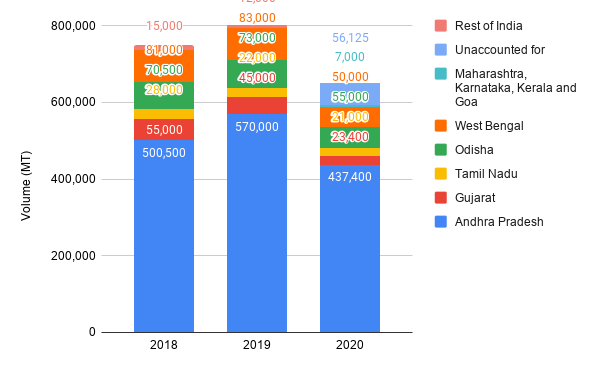
Source: For the statistics concerning 2020: SAP data presented in its 2020 crop review; for the statistics concerning 2018 and 2019: SAP data presented at Aqua India 2020
SAP’s production estimates from 2019 and 2020 suggest that production in Odisha and West Bengal declined by 25% and 40% respectively. While stocking in both states would normally start in mid-February, the lockdown and the following shortage of post-larvae (PL) made farmers only stock the majority of their ponds by May or even June. Most farmers had two crops straight after each other or chose to only have one crop. In the second half of the year, disease reportedly heavily affected the farmers that chose to have a second crop. In my opinion, the drop in production in Odisha and West Bengal will be short lived; continuous expansion of farming areas in the two states gives enough reason to believe that production will increase over the next couple of years.

In the northern part of Andhra Pradesh (Srikakulam to Krishna), SAP reports production to have dropped between 10-20% depending on the district. In the southern districts (Guntur to Nellore), production actually increased. The decline in production in the northern parts of the state mainly occurred during the first half of the year when panic harvesting during the early stages of the lockdown and subsequent disruptions accounted for most of the production loss. Throughout the year, farmers struggled with disease but they adapted their strategies and, especially during the second half of the year, output in the northern part of the state drastically improved and maybe even outperformed the same period in 2019. In the southern districts, despite COVID-19 disruptions, due to improved rainfall during the first crop of 2020 the harvest of that crop outperformed 2019. The overall performance in the south was tempered during the second half of the year when cyclone Nivar caused damage and disease was more prevalent. Comparing the numbers of SAP’s 2020 and 2019 crop reviews suggests that total production in Andhra Pradesh may have dropped by as much as 25%.

While I'm not really surprised by SAP’s data for most of the states, the data presented for Gujarat is quite unexpected. SAP reports a strong decline in production from 55,000 MT in 2018, reducing to 45,000 in 2019, and then further to only 23,000 MT in 2020. According to SAP’s members, Gujarat’s decline in production is partly to be blamed on climate conditions and a COVID-19-related shortage of PL. But the main source of blame is the unregulated expansion of farming areas over the past decade that has led to the current context of various production issues. Yet Gujarat has often been mentioned as the largest expected contributor to India’s future shrimp output. At the Global Aquaculture Alliance Shrimp Session during the Boston Seafood Show in 2019, Elias Sait, the secretary general of the Seafood Exporters Association of India (SEAI), even mentioned that out of a possible increase in shrimp production of 450,000 MT by 2022 in India, Gujarat could contribute as much as 250,000 MT. If SAP is right and production in Gujarat more than halved since its peak in 2018, what remains of Gujarat’s promised contribution?
EXPORT VOLUME DOWN 14%: CHINA SEVERELY HIT, AND PRESSURE ON MARKET SHARE IN THE US
India’s exports took a big blow in 2020 and dropped to 575,000 MT, down 14% compared to 2019 and 7% compared to 2018. While exports of raw frozen products were down by almost 17%, exports of cooked and value-added products were up by 37% year-on-year. India, China, and the EU account for 48%, 17%, and 11% of India’s exports respectively.
Figure 2: India’s shrimp export volumes 2018-2019
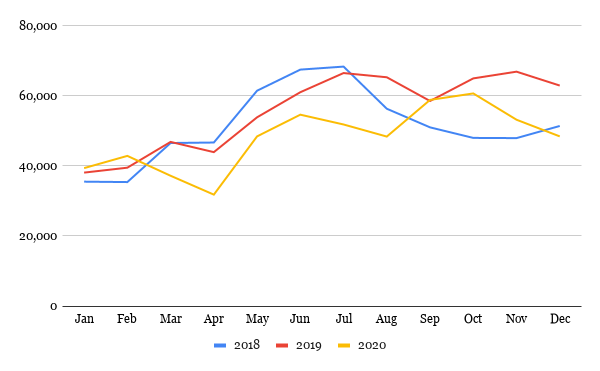
Source: Ministry of Commerce, India
Amid a surge of US imports, India’s exports to the US declined by 5% to 271,000 MT. This decline in exports was mainly accounted for by peeled shrimp (-12%, i.e. -21,200 MT) and shell-on shrimp (-9%, i.e. -7,400 MT). Exports of cooked shrimp and breaded shrimp increased by 55% (i.e. 14,000 MT) and 150% (i.e. 178 MT) respectively (see Table 1). Of course, it’s great that India managed to increase its exports of cooked and value-added products. But its loss of market share for peeled products and shell-on products worries me.
and other proteins such as chicken and fish in the local market
Table 1: India, Indonesia, and Ecuador exports of frozen warmwater shrimp, and the US’s total imports of the same products in 2019 and 2020
Source: NOAA
India remains the largest exporter of raw peeled products accounting for just over 50% of US total imports of these products in 2020. However, exports were down year-on-year by 20,000 MT in 2020. This loss in volume was largely replaced by Ecuador, which increased its exports of raw peeled products by 15,000 MT. Shell-on products were responsible for 36% of the US’s total imports and increased 9% year-on-year compared with 2019. While in 2019 India was by far the largest supplier, in 2020 it lost market share of shell-on products to Ecuador and Indonesia. Ecuador and India both supplied 73,000 MT to the US, while Indonesia supplied 63,000 MT. The US mainly increased its imports of large sizes and especially Indonesia benefited from that. The US also increased imports of mid sizes, but India exported 14% less than in 2019. As a result, Ecuador became the US’s largest supplier of mid sizes in 2020, increasing its exports 64% year-on-year. Although it is not sure whether this product has actually been sold or is inventory, I assume that the amount that has been sold is underestimated as the shell-on category also includes headless shell-on easy peel (HLSO EZP), which is a large retail product in the US and may have moved fast.
Exports to China were harder hit than exports to the US, and declined by more than 35% from almost 160,000 MT in 2019 to just over 100,000 MT in 2020. Exports to China were severely disrupted due to COVID-19-related issues, but also due to other political issues. It remains to be seen how fast Chinese demand for Indian shrimp will recover. With China being India’s most important market for smaller-sized shrimp, China’s recovery will be crucial for India’s 2021 outlook.

LWE CALCULATION: FARMED SHRIMP PRODUCTION DOWN ONLY 10%
To cross-check SAP’s figures, we can use India’s export data to calculate an LWE farmed shrimp production estimate (see Figure 3). Applying the LWE ratios provided to me by a major exporter – even if we were to first deduct 50,000 MT of wild-caught shrimp – would result in a farmed shrimp production estimate of 701,000 MT. This is a bit above SAP’s estimate, but still down by 10%. This is less than the drop in exports of 14%, and is explained by the lower LWE used for 2020 due to a decline in exports of raw material to China and an increase in exports of cooked products to the US. But this calculation has to be taken with a pinch of salt as the LWE is primarily based on assumptions.
Figure 3: India’s shrimp production estimate based on an LWE of export volumes of farmed shrimp
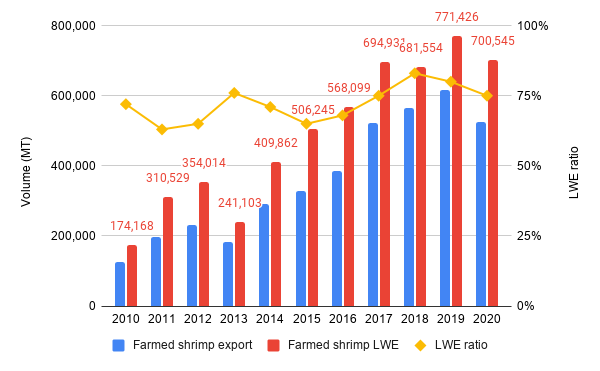
Source: Export volumes: Ministry of Commerce, India; LWE ratios: provided by one of India’s major exporters (anonymous)

SHORTER CROP CYCLES MEAN SMALLER SHRIMP AT HARVEST TIME
In addition to the production estimate in its crop review paper, SAP also presented some key trends among India’s farmers. Two of those caught my attention: first of all, compared to 2019, stocking densities in most regions were down to 20-40 PL/m2. Only in the southern districts of Andhra Pradesh, West Bengal, and Tamil Nadu were densities of both 20-40 PL/m2 and 41-60 PL/m2 common; secondly, SAP also found that the duration of crops had decreased from 110 days to 90 days, and, wherever possible, farmers went for three or four crops per year. These shorter crop cycles resulted in predominantly smaller-sized shrimp. Across India, shrimp sizes were predominantly 10-16 grams (61-100 count per kg). Looking at specific regions, however, producers in West Bengal and Odisha produced mainly 15-25 grams (41-60 count per kg), and producers in Gujarat 25-33 grams (31-40 count per kg).
Photo 1: A shrimp harvest in Andhra Pradesh
Source: Shrimp Insights
One of my contacts in Odisha mentioned to me that we should not overestimate the potential of a surge in output of small sizes. According to this source, in Odisha and also in West Bengal, it will be hard to produce small sizes because of a lack of profitability for the farmers. He explained that normally profit margins would only become reasonable from 50 count per kg and larger. But now, since costs – such as for diesel – have increased, this may even have become 40 count per kg and larger. Although he admits that this may be different in Andhra Pradesh where farmers are closer to most input suppliers and are better connected to the electricity grid, he has a hard time believing that producing larger volumes of shrimp at smaller than 60 count per kg would be a sustainable future for India’s shrimp industry. This is echoed by one of India’s largest exporters in Andhra Pradesh that says that smaller sizes are mainly in demand from the Chinese market and the US retail market. Being reliant on the Chinese market is very risky due to the volatility of that market. The company is hopeful that, if this year US food service demand drives prices of larger sizes, farmers might be encouraged to produce larger sizes again.
Even with these warnings in mind, I can’t help but wonder what last year’s trend for shorter crop cycles and smaller harvest sizes might mean for the structure and dynamics of the Indian shrimp industry if it stays this way for the next couple of years…
EXPORTS OF SMALLER SIZES TO CHINA: CHANGING INDIA’S SHRIMP INDUSTRY?
Well known exporters like Devi Seafoods, Devi Fisheries, Nekkant, Apex Frozen Foods, and Avanti depend on the US market for around 80% or more of their exports. The main type of business these companies do in the US is program business for large wholesalers and food service operators, and a wide diversity of retailers. The types of contracts and relationships they engage in provide incentives to invest in various segments of the supply chain in India to ensure that they have access to the right types and volumes of raw material at the right time. They have hatcheries and feed mills (or have dealerships), and capture farmed shrimp production in their supply chain through direct ownership and the lease of farms, or through buy-back arrangements with independent farms. These companies use their own farmers as well as farmers that they finance to produce larger sizes. Because their US clients also require sustainability certification and the assurance that companies operate according to social compliance standards, these companies also drive the expansion of certification schemes, such as BAP and ASC certification, contributing to the sustainability of India’s industry.
Photo 2: Harvested shrimp
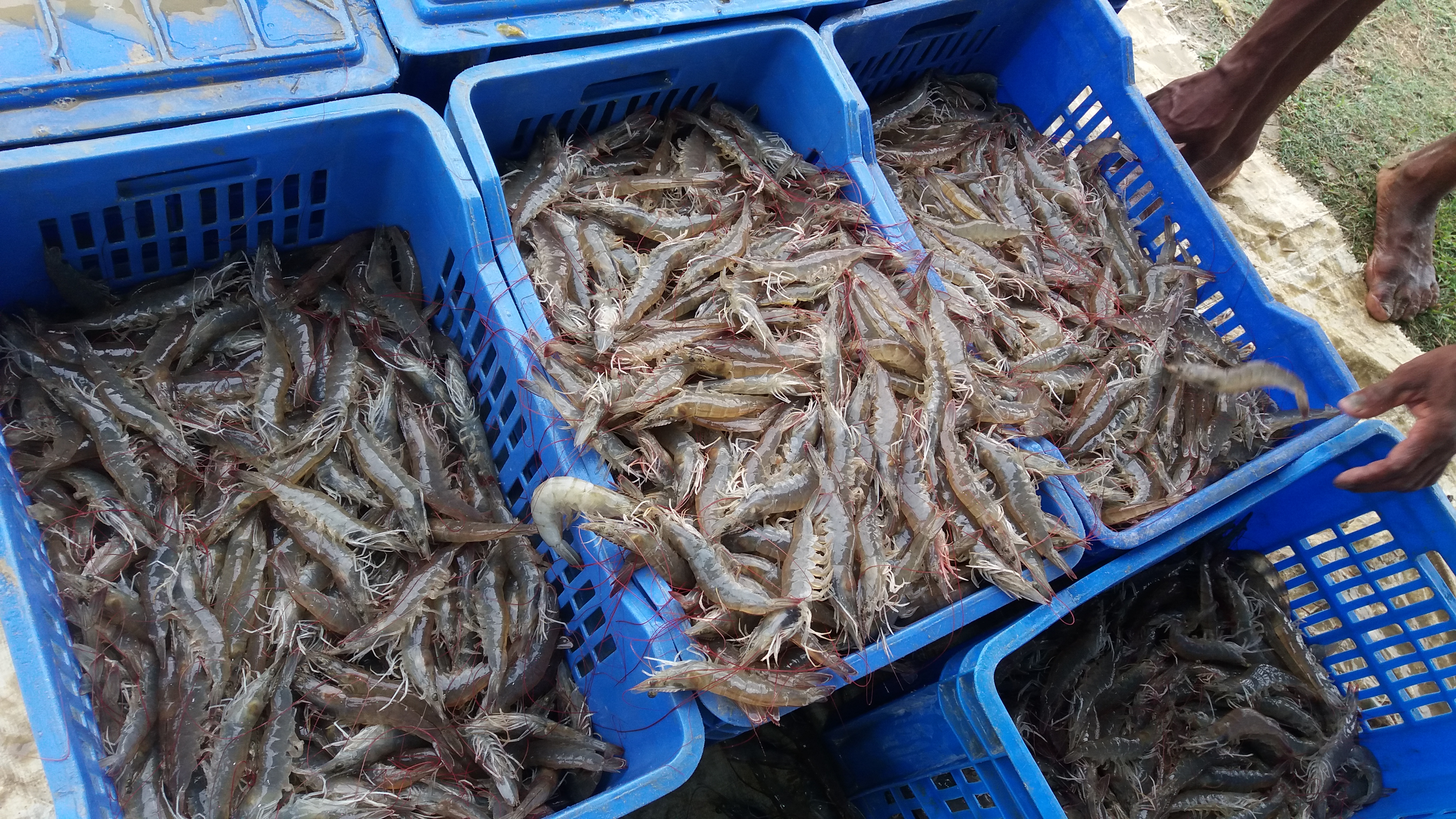
Source: Aditya Dash
Other companies, such as Growel, CP India, and Sreeragam are much more oriented to the HLSO bulk business with China’s reprocessors, and only do a small amount of business with the US. For their business with China, they require the smaller sizes. For these companies focused on China, there is often little incentive for them to engage in buy-back arrangements, and it is certainly much less the case than for US-focused companies. Instead, due to the volatility of the Chinese market and the type of buyers these companies focus on, China buys most of its raw shrimp from the spot market. Although companies like Growel and CP India are, of course, involved in the Indian supply chain for their feed businesses, processing and exports are not their primary focus. This possibly explains why they choose to do business with China instead of with the more demanding US buyers.
If India will primarily increase its output of smaller sizes, it might mean that exports need to target the Chinese market, which has the highest demand for smaller shrimp. It is feasible that the companies that process and export the shrimp for China will be less incentivized to drive certification and forward integration in the supply chain. We may well, therefore, get a stronger divide between the part of the industry that is integrated to serve the US market and the part that is fragmented and operates more on a spot market-basis to serve the volume-driven Chinese market.
TOLERANT BROODSTOCK LINES: ENABLING A RETURN TO LARGER SIZES AND HIGHER DENSITIES?
The focus on smaller sizes is attributed to certain market and production issues. But from the production side, there might be a solution on its way. As mentioned in my previous blog, some of India’s hatchery operators in the latter part of 2020 ordered several batches of disease-tolerant broodstock from suppliers such as Shrimp Improvement Systems (SIS) and Kona Bay, as well as the High Vigor broodstock of American Penaeid Inc. (API). These stocks are superior animals in terms of their survival rates under harsh conditions. In a conversation I had with Ravi Kumar Yellanki, managing director of India’s largest Vaisakhi hatchery group, he mentioned that the uptake of these tolerant lines might be slow. He suggested that at first only larger corporate farmers would make use of these. The majority of farmers in India, according to Yellanki, are still focused on growth. But once the success of the tolerant lines is proven, we might see more farmers go for them.
Photo 3: Pond stocking in Odisha
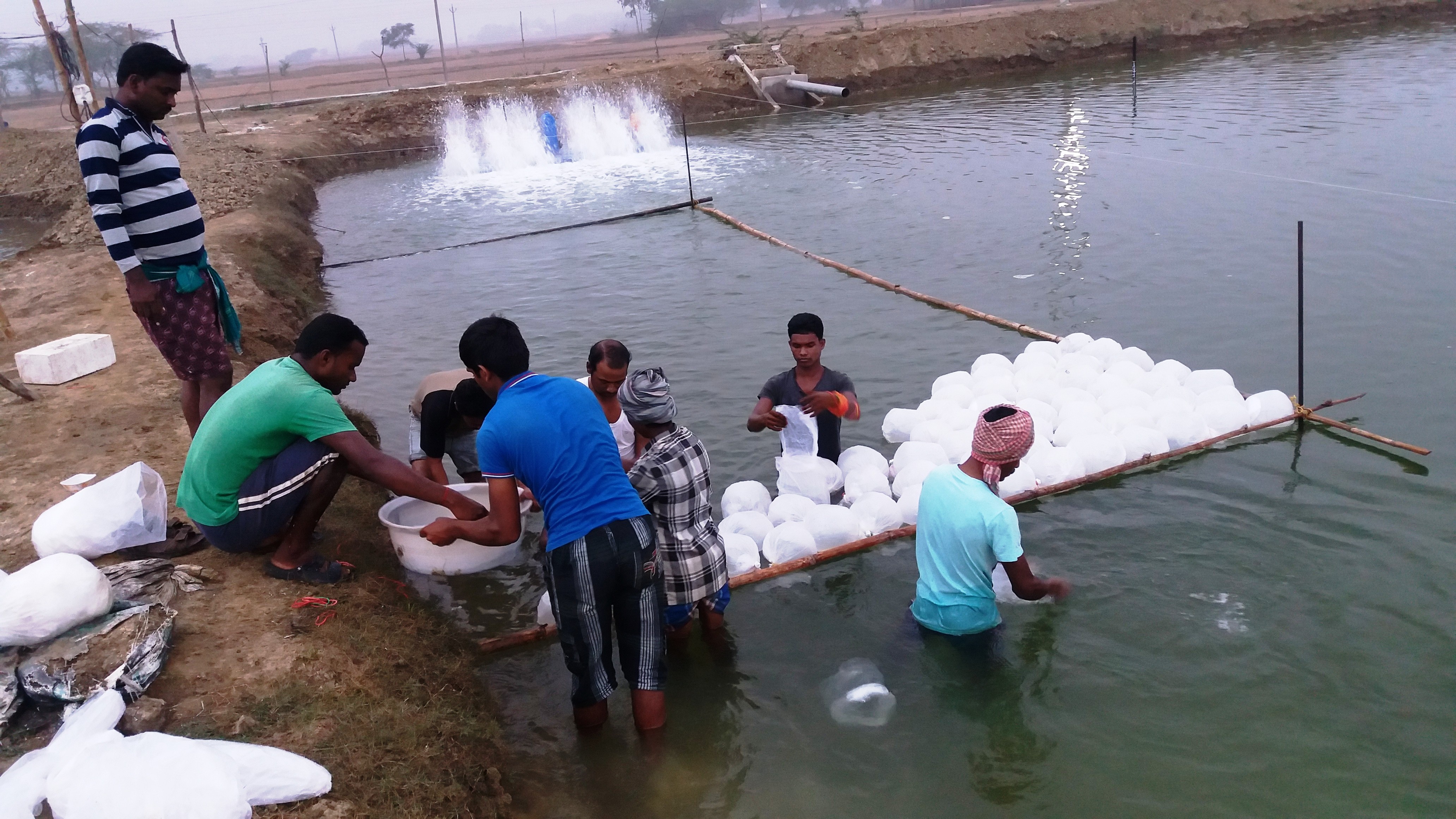
Source: Aditya Dash
If successful, the use of tolerant lines could have a big impact on production. US-oriented exporters that need larger sizes for their program business might start encouraging farmers to use tolerant lines. If farmers can grow these PL into larger sizes with less risk of disease, this would supply exporters with more raw material. More importantly, if these PL outperform the conventional lines, farmers might also choose to increase stocking densities when using these PL, contributing to better productivity and more farmed shrimp production.
CONCLUSION
Overall, I expect India to struggle to recover production in the first half of 2021 due to two main reasons: on the one hand, we have the uncertainty of the US – where high inventories will possibly temper demand in Q2 – and Chinese markets – that have a preference for domestic shrimp due to COVID detections in imported shrimp; on the other hand, we see ongoing challenges with disease. However, I’m still confident about India’s outlook. Having in mind the current low stocking densities in Andhra Pradesh, the amount of land that might still be converted into shrimp ponds in Gujarat and Odisha, and India’s relatively low production costs compared to most of its Asian peers, I am sure that – in the long run – India will be a major contributor to the expected surge of global farmed shrimp production. I even believe that under the right conditions, India’s own surge in production might come sooner than we expect. If the market and production conditions are suddenly favorable, India’s farmers can easily increase their stocking densities. Even an increase of 20/40 PL/m2 to an average of 30/60 PL/m2 if successfully harvested will mean an increase of 25% to 50% in terms of output. This means that production could suddenly reach somewhere between 800,000 MT and 900,000 MT. But with a couple of hundred additional ponds, India may very well suddenly cross the 1 million MT production mark.
Just like SAP’s crop review, my observations are also subject to my own assumptions, uncertainties, and opinions, and also the opinions of my blog’s reviewers in India. Therefore, you should all remain critical and engage in the discussion if you happen to disagree!